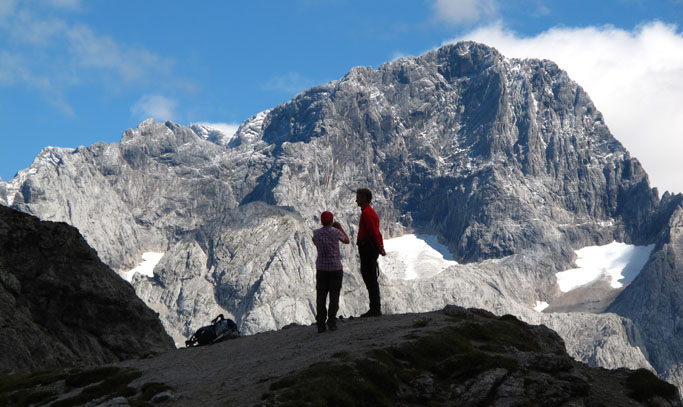Geography and Location
Brilliant blue lakes, verdant valleys, and towering peaks with cascading glaciers characterize the Lake District surrounding Salzburg Austria and the Dachstein, a UNESCO World Heritage Site and the Alps northernmost high limestone range. Also known as the Salzkammergut, the region has been the playground and vacation destination for Monarchs and Noblemen for centuries, if not millennia. In fact, many of the villages in this region boast human habitation that goes back 7,000 years, as evidenced by various artifacts discovered throughout the years.
The Salzkammergut sprawls east of Salzburg, a hilly region best known for its 76 lakes. Between these lakes, however, are some of Austria’s most beautiful forests – and lots and lots of salt. In fact, the salt mining industry made the Salzkammergut the most contested region in Austria, a battle for wealth between the Hapsburgs of Vienna and the prince-archbishops of Salzburg.
Today, the Salzkammergut’s wealth lies not in salt but in tourism, and the region hosts guests year-round – in winter for the excellent, mostly easy, ski runs; in spring and summer for its lake sports and hiking and biking trails; and in fall, for Austria’s most spectacular display of seasonal color.
Outdoor Attractions
While the lakes and the hills are as beautiful as can be, the Dachstein group to the west is what attracts most mountain lovers. This mountain massif in Styria reaches its maximum elevation at the Hoher Dachstein (9,826 feet [2,995 metres]). Among the massif’s higher reaches are the easternmost and northernmost glaciers of the Alps, the largest of which is the Hallstättergletscher, 2 square miles (5.3 square km). The Alpine scenery of the massif attracts skiers and mountain climbers, and the ice and limestone caves of the Dachsteineishöhle and Koppenbrüllerhöhle provide further attractions. Some 240 other caves have been identified on the massif.
Cuisine
Austrian cuisine in general: It is the culinary reflection of an ethnically mixed people who, during the many centuries of the Austrian Habsburg empire’s expansion and contraction, have exchanged culinary know-how with Turkish, Swiss, Alsacian, French, Spanish, Dutch, Italian, German, Bohemian-Moravian, Hungarian, Polish, Croatian, Slovenian, Slovakian, Serbian, and Jewish cuisine. Typical Austrian dishes vary today according to the Bundeslander culinary history and to each “Bundesland’s” agriculture with its export/import tradition.
Burgenland Cuisine
For example, Burgenland cuisine is influenced by its flat topography and proximity to Hungary. Its specialties are prepared with abundant locally grown fruits and free roaming chicken and geese and include dishes like the “Buergenlandisches Erdbeerkoch” (a type of baked strawberry mush dessert) and “Buergenlandische Gaenseleber” (goose liver simmered with onions).
Mediterranean Flair
East southern Kaernten/Carinthia and Steiermark/Styria’s cuisines, with Hungarian, Yugoslavian, and Italian culinary influences, feature Mediterranean style foods. These include ham, a favorite ingredient in all three surrounding countries, and mild climate herbs and vegetables. Dishes from these areas include “Steirisches Verhackert’s” (diced “Speck” (Austrian cured ham) mixed with minced garlic and heavy flavored pumpkin seed oil) or “Steirisches Poulard” (roasted herb stuffed capon or chicken).
Lower Austria Specialities
Niederoesterreich/Lower Austria’s way of cooking reflects historic ties with eastern, Middle Eastern, and oriental cooking, and includes “Serviettenknoedel mit Semmelkren” (baked bread loaf with saffron gravy) and “Gezogener Apfelstrudel” (an almost transparent roll of pastry dough filled with apples which has common culinary roots with oriental “baklava”).
Upper Austria Specialties
Oberoesterreich/Upper Austria and ancient Salzburg states, which border with Germany and the Czech Republic include culinary classics like the well known “Linzertorte” (a flaky cake lined with currant or raspberry jam, encased and covered by a lattice of cake dough), and Mozart’s home town’s specialty, “Salzburger Nockerln” (a very light dessert souffle dusted with vanilla sugar).
Tirolean and Vorarlberg Specialties
Tirolean and Vorarlberg specialties, inspired by ingredients native of mountainous poor soil and cool wooded areas with a tradition of importing from Italy and exchanging with Switzerland, include “Tiroler Leber mit Polenta” (veal or beef liver with onions, “speck,” capers, lemon juice, and white wine served on corn mush), “Groestl” (sliced pan-fried onions and potatoes with or without meat), or “Schlutzkrapfen” (spinach stuffed pasta pockets, served like “ravioli,” without tomato sauce only topped with melted butter and Parmesan cheese).
Due to the city’s historic past steeped in European history, Vienna’ s cuisine is unique and international. Viennese specialties were created by, and for, people who were influenced by a monarchic system that until the early part of this century was among the most influential European political powers and which had cultural ties to Europe as well as the American New World.
Historic Influence on Regional Flavors
As Vienna’s Habsburg royal family was involved in power politics as far away as Spain, its cuisine absorbed many international ingredients. Viennese cuisine includes “Wiener Schnitzel” (breaded veal cutlet which has its twin version in Milan, Italy, called “Cotoletta alla Milanese”), “Parmesanschoeberlsuppe” (clear broth with diamond-shaped Parmesan cheese flavored souffle dumplings created after Vienna’s political power became dominant in Northern Italy), and Fiaker Goulash (Viennese paprika beef stew very similar to chili and to Hungarian goulash), and, of course, the renowned Sacher Torte (chocolate glazed cake filled with either apricot, currant or raspberry jam).
Typical Austrian Fare
A typical Austrian meal includes usually from 2 to 7 courses according to the importance of the meal’s guest or occasion. It is usually made up of an appetizer (Vorspeise), a soup (Suppe), and the main course (Hauptspeise) with one or two either raw or cooked side dishes (Beilagen). It may also include a dessert that can be either a cake (“Kuchen” or “Torte”), any baked specialty made with flour (“Mehlspeise”), or a warm or cold after-meal sweet treat (“Nachspeise”).
With a fine meal, Austrian adults favor drinking either beer, wine or “sekt” (sparkling wine). Fruit juices, soft drinks like fruit flavored waters, and wine spritzers are also favorites among the younger generation of Austrians.









Comments are closed.